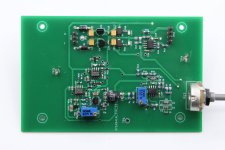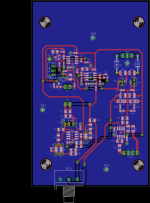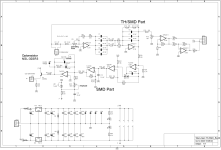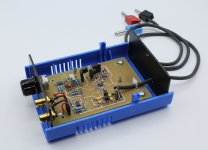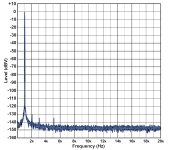Nice work, Jesper! So, the hardware is pretty much done I assume. While the basic noise floor is just a bit higher, the harmonics are all lower. Could we blame it to the extra gain of the ABM? Do you recall if the pot of the Behringer's modified input -the back panel control- was at the same level for all measurements? Also, when time allows, could you repeat the first measurement with inputs floating?
Thanks for the reply's.
I allways forget to write the setup conditions, sry... 🤔
The input attenuator on the Behringer is not touched, allways at it's MAX (all the way to the right for minimum resistance)
Input's are floating as you explained me post https://www.diyaudio.com/community/threads/behringer-umc-202hd-for-measurements.341309/post-7502670
I did check my cables one's more and took some new fresh shoot's, with a bit more explanation.
I also attached the Outputcard schematic here.
You are absolutely right, that the output card is adding just a tiny bit of noise.
RED = Directly to Behringer, Green, Blue and Orange through SuperRanger.




I allways forget to write the setup conditions, sry... 🤔
The input attenuator on the Behringer is not touched, allways at it's MAX (all the way to the right for minimum resistance)
Input's are floating as you explained me post https://www.diyaudio.com/community/threads/behringer-umc-202hd-for-measurements.341309/post-7502670
I did check my cables one's more and took some new fresh shoot's, with a bit more explanation.
I also attached the Outputcard schematic here.
You are absolutely right, that the output card is adding just a tiny bit of noise.
RED = Directly to Behringer, Green, Blue and Orange through SuperRanger.
Thanks! My mistake to use the term "floating". What I meant was with input full open, not shorted.
This is not exactly related to this discussion, but I thought that this would be the best place to ask, with so many knowledgeable people.
About the behringer UMC202HD. I need to know what is the component marked D2 on the board and the specs so I can look for a replacement. It looks like some sort of diode and it has the marking P5 on it. (See circled component on pic below). It's on the tracks of the USB data(+) and (-) input from the cable before they both go on to reach the XMOS chip.
I'm asking this because someone handed me a UMC202HD that's busted. To make a long story short, the solder of the USB-B female port eventually broke after years of plugging it in and out. The former owner decided to remove it altogether and wanted to make the USB cable connect directly onto the board. Unfortunately, as he tried to do so, he ended up damaging the component that's marked D2, right behind the USB-B connector.
I'm no expert and I don't have a lot of knowledge regarding components but I've had some success in repairing parts of circuit boards in the past.
I told him I'd give it a try, but I just need a replacement for that tiny part.
Thanks for your help!

About the behringer UMC202HD. I need to know what is the component marked D2 on the board and the specs so I can look for a replacement. It looks like some sort of diode and it has the marking P5 on it. (See circled component on pic below). It's on the tracks of the USB data(+) and (-) input from the cable before they both go on to reach the XMOS chip.
I'm asking this because someone handed me a UMC202HD that's busted. To make a long story short, the solder of the USB-B female port eventually broke after years of plugging it in and out. The former owner decided to remove it altogether and wanted to make the USB cable connect directly onto the board. Unfortunately, as he tried to do so, he ended up damaging the component that's marked D2, right behind the USB-B connector.
I'm no expert and I don't have a lot of knowledge regarding components but I've had some success in repairing parts of circuit boards in the past.
I told him I'd give it a try, but I just need a replacement for that tiny part.
Thanks for your help!
It is a double diode for electrostatic discharge protection -ESD. Supposedly, the Xmos microcontroller has one built-in. The soundcard should work without it but it's an additional safety measure. I don't know the exact part but search for TVS diode for high speed usb in SOT323 package.
Hi all,
just want let you know that I designed an analog 1 kHz generator with low distortion.
It is described in Elektor: https://www.elektormagazine.com/magazine/elektor-346/62910
Here are some pics.
Might be a good companion to the Behringer.
just want let you know that I designed an analog 1 kHz generator with low distortion.
It is described in Elektor: https://www.elektormagazine.com/magazine/elektor-346/62910
Here are some pics.
Might be a good companion to the Behringer.
Attachments
Thanks for sharing Alfred. Impressively low distortion! I don't have an immediate need for such an oscillator, but if you want to know the real performance of your ADC, this certainly comes in handy. I relied on loopback measurements, but then the measured THD includes DAC performance as well.
Jan
Jan
Agreed. Sometimes it may help to insert some passive lo-pass filter into the loop to improve THD of the DAC.
- Home
- Design & Build
- Equipment & Tools
- Behringer UMC 202HD for measurements
